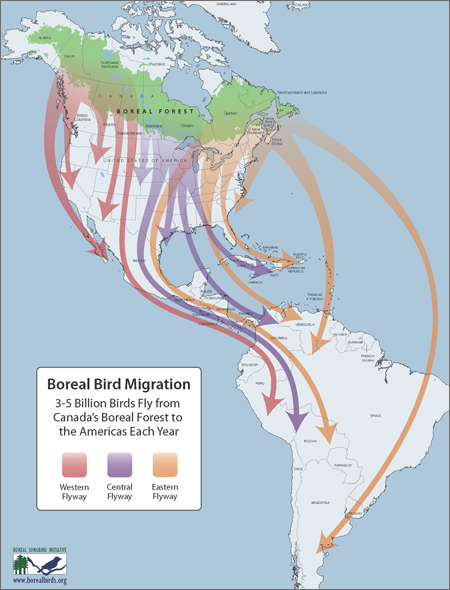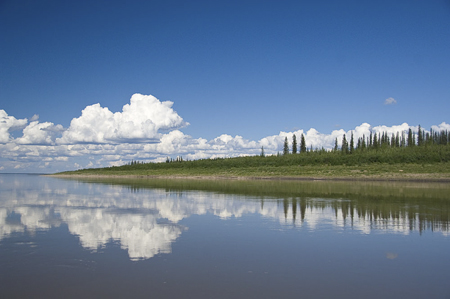
The Mackenzie River - largest in Canada
Credit: Irene Owsley
Canada’s boreal forest is big. Real big.
At 1.4 billion acres (think of two Argentinas), this lush and varied landscape spans the middle third of Canada like a green scarf. But it’s not all green. The retreat of ice from the last ice age has left the boreal with millions of pristine blue lakes speckled across its terrain—the largest concentration anywhere in the world—as well as countless undammed, free-flowing rivers that carve through the vast expanses of trees.
This is in part what makes Canada’s boreal such a Mecca for migratory birds. Billions of birds—from songbirds and raptors to waterfowl and shorebirds—flock there every summer to take part in one of the largest breeding occurrences on Earth. The plethora of lakes, wetlands and rivers form ideal habitat for waterfowl and shorebirds and produce a feast of insects for a variety of land birds. The waves of migrants heading south each fall can be found in every corner of the United States and, in the case of the Hudsonian Godwit, as far away as the Tierra del Fuego.
As with any great forest ecosystem, however, it is seeing its fair share of industrial threats. Demand for paper and wood products, sources of electricity, mineral resources and our seemingly never-ending thirst for oil are pushing an industrial footprint further and further into the heart of the boreal each year.
You would be hard pressed to find a part of the boreal absent of many birds, but three particular aquatic-friendly regions are becoming areas of particular concern. These were highlighted in the newly-released report Birds at Risk: The Importance of Canada’s Boreal Wetlands and Waterways, a collaboration between the Boreal Songbird Initiative, the Natural Resources Defense Council and Nature Canada, of which I was a co-author.
The Hudson and James Bay Lowlands
From a plane, the vast expanses of lakes, wetlands and muskeg that sweep across the Hudson and James Bay Lowlands of Manitoba, Ontario and Quebec seem to stretch endlessly into the horizon. Parts of it almost do, as the northern portions in Ontario and Manitoba form part of the largest intact block of forest anywhere on earth. The coastal tidal zones and interior wetlands provide vital breeding grounds for a whopping 28 species of waterfowl, 21 waterbirds, including loons, terns and herons, as well as 19 types of shorebird. It also serves as an important stopover habitat for many species that breed further north in the Arctic. The 33 recognized Important Bird Areas within the region demonstrate just how wealthy this landscape is from a bird perspective.
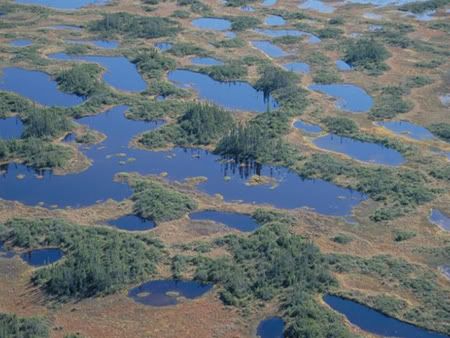
James Bay Lowlands
Credit: Evan Ferrari
However, some of the largest and most important rivers that flow through this vast drainage basin have been dammed, most notably in the James Bay region of Quebec and Hudson Bay lowlands of Manitoba. Touted as being “green” compared to other sources of electricity, dams still cause notable detrimental effects on breeding and stopover habitat for birds. Reservoirs created by dams flood important habitat—the James Bay Project in Quebec alone has flooded as much as 5,135 square miles, lost habitat for an estimated 5 to 10 million birds—and block important nutrients and natural flows that spur life further downstream. Mercury contamination within these artificial lakes is also a major concern. Fish in reservoirs of the James Bay Project have been unsafe to eat since the 1980s, and such contamination inevitably affects predatory fish and birds higher up in the food chain.
The Peace-Athabasca Delta
The Peace-Athabasca Delta, a major freshwater delta where the Peace and Athabasca Rivers meet and eventually descend into Great Slave Lake and then into the Mackenzie—Canada’s largest river—is one of the most important regions for birds, particularly for waterfowl and shorebirds, anywhere in the world. Its location in northern Alberta positions it uniquely at the confluence of three major flyways: the Pacific, Central and Mississippi. It is one of the largest freshwater deltas in the world and is filled with numerous inlets and small lakes and ponds, which make for perfect conditions for a wide variety of birds. Upwards of 215 birds have been recorded in or near the delta, and spring and fall migrations through the region are staggering. Large spring migrations have seen more than 400,000 waterfowl and over 1 million birds returning south in the fall. It’s also vital for a number of shorebirds and waterbirds, and the adjacent Wood Buffalo National Park poses as the last natural breeding grounds for the endangered Whooping Crane.
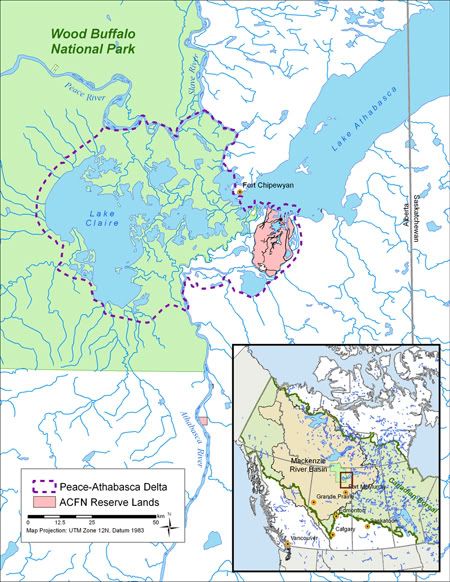
The Peace-Athabasca Delta in northern Alberta
The W. A. C. Bennett Dam upstream in the Peace River, installed in the 1960s, has reduced flows into the Peace-Athabasca Delta for decades and has become a source of concern among First Nations. The Peace River is integral to the formation of many of the small inlets and ponds heavily used by birds and further flow reduction could become a reality if the proposed Site C Dam is allowed to proceed as planned. In addition to reduced flow, there is considerable concern about contamination of the Athabasca River due to tar sands development upstream from the Delta. Higher rates of cancer in nearby Fort Chipewyan as well as documentation of deformed fish in the region have elevated fears that contaminants are leaking downstream, including into the Delta.
The Lake Superior Watershed
Lake Superior, which straddles the United States and Canada, is the largest freshwater lake by surface area in the world. Exposed granite, dense bedrock and thin soils throughout the northern portion of its drainage basin create irregular drainage patterns and have left the region heavily packed with small lakes and wetlands. Several boreal-breeding birds experience their highest breeding densities in the region, including the bug-loving Olive-sided Flycatcher and Alder Flycatcher. Many warblers flourish in the mix of wetlands and coniferous and deciduous trees.
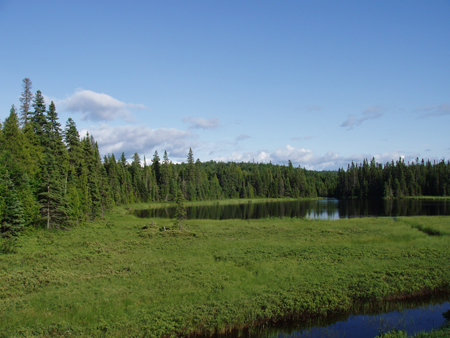
One of the many small lakes in Lake Superior Provincial Park
Credit: Matt Medler
The dense stands of trees common throughout the region have enticed numerous logging operations and the network of roads present has made much of the area easily accessible. While companies on Crown land replant areas following harvest, replanted regions rarely return to original conditions, particularly when herbicides, pesticides and large-scale machinery are used in the process. These replanted swaths typically lack diversity and many species of bird are unable to use the area.
Enacting Bird-Friendly Policies
There are countless policies that could help some of our threatened boreal species. In addition to elevating the importance of bird-friendly practices within all industrial developments and land and water uses, the following four policy adoptions would go a long way toward ensuring healthy numbers of migrants return to and breed in the boreal each year.
-Recognize the global importance of Canada’s boreal forest. Recognizing the importance of this region from an international perspective—emphasizing migratory birds—would boost efforts throughout the forest to better protect it. Additionally, increasing the number of Important Bird Areas, Ramsar Wetlands and UNESCO World Heritage Sites within Canada’s boreal would ensure better management and conservation of some of Canada’s most important breeding and stopover habitats.
-Adopt the principles of the Boreal Forest Conservation Framework. Striving to protect at least half of Canada’s boreal forest from industrial development would guarantee large portions of habitat throughout the boreal would remain mostly undisturbed well into the future. Working in tandem with local First Nations would ensure conservation planning and mapping is done carefully, thoroughly and held to the highest of ethical standards.
-Preserve healthy water ecosystems. Hydroelectric developments and logging have degraded previously intact water ecosystems throughout much of the boreal, particularly within the south. In addition to enhancing better management practices within these types of development, identifying and protecting pristine source-to-mouth ecosystems would go a long way toward guaranteeing a safe and healthy future for boreal birds well into the future.
-Protect the James Bay Lowlands, Peace-Athabasca Delta and Mackenzie Basin. These regions not only form vital breeding habitat for a plethora of birds, but all three contain large areas that are still intact. Working with First Nations, these areas should remain at the highest of conservation priorities within Canada, with serious opportunities to expand protection across broad tracts.
Solitary Sandpiper—one of the boreal breeding shorebirds profiled in the report:


